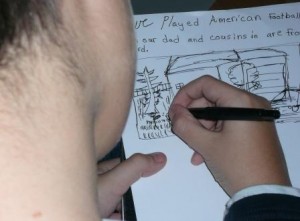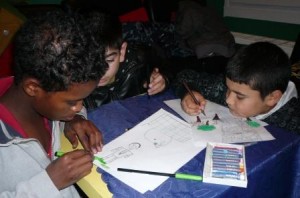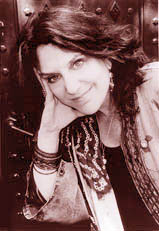Tuesday
Dharma TeachingsPart 2: When Monsters Become Protectors
 The Transformational Power of Storytelling
The Transformational Power of Storytelling
By Laura Simms
This story of The Transitional Place reflects what I feel I have begun to understand about the possibility of transforming energy through story. This is at the root of what I want to continue to do with young people, especially those who aren’t brought up in a culture that traditionally shares storytelling. In American public school classrooms, I frequently ask kids where their families come from. Almost everyone comes from different places in the world. While in America, we don’t have a single mythic culture, we have an entire universe of tolerance and diversity that can be drawn on if we become more intelligent about the nature of stories. Rather than presenting anecdotes that lead to a moral lesson, by telling stories we deepen our young people’s capacity to develop discernment and feel the experience of genuine well-being. Listening to the story becomes a visualization practice in which fixed states of mind are transformed by rich images. This practice settles the mind, and the children gain focus and pliability. An alert curiosity develops: they want to know what is going to happen next.
In cultures rooted in tradition, there are wisdom stories that communicate the truth of interdependence with nature, ancestors, spirituality, each other. They also share our love for humorous and zany human foibles. There are sophisticated sagas and also teaching stories. We live in a landscape of stories that often drive much of our lives. Too often, we are barely aware of our inner storytelling, rife with assumptions, interpretations, and beliefs about what’s real, how things should be, and who we are. That’s the unconscious level of storytelling that most of us live with.
Everybody has ancestors — whether Eastern European, Irish, African, Far Eastern, Indian or Tibetan. I encourage young people to appreciate where they came from, their own sense of lineage, because it can offer a sense of continuity and the pride of coming from somewhere. The stories bring these things home, on inner and outer levels. Traditionally, what makes these cultural stories so rich for many young people is that the oral tradition is being passed to them as they listen. In villages without electricity there is tremendous variety in the styles of storytelling. If you grew up in one of those cultures, you would hear the truly great storytellers, and you would also hear your grandfather or mother reciting tales. Because the story is lived in the listening there is a respect for the teachings in the stories even if they are not fully understood. The act of listening in this way is a stem that reaches down like roots into basic goodness.
 If we bring traditional stories and engaged storytelling back into our lives, we can create and share templates for compassionate living. Listening to stories is a continual process of becoming more and more familiar with the flexibility and power of our minds, similar to becoming familiar with our minds in sitting meditation practice. Telling our children stories is a great preparation for sitting practice, because they are learning to place their minds on the story spoken and the images arising from within themselves. They are coming back to vast mind and learning to experience complex feelings without disassociating, being overwhelmed by them, or getting swept away. As stories flow from one character to the next, one emotion to the next, one situation to the next, things change and this becomes practice for life.
If we bring traditional stories and engaged storytelling back into our lives, we can create and share templates for compassionate living. Listening to stories is a continual process of becoming more and more familiar with the flexibility and power of our minds, similar to becoming familiar with our minds in sitting meditation practice. Telling our children stories is a great preparation for sitting practice, because they are learning to place their minds on the story spoken and the images arising from within themselves. They are coming back to vast mind and learning to experience complex feelings without disassociating, being overwhelmed by them, or getting swept away. As stories flow from one character to the next, one emotion to the next, one situation to the next, things change and this becomes practice for life.
The added adventure of creating our own stories based on the principles of transforming aggression into compassion, monsters into protectors, and misery into joy is internal alchemy. You don’t have to be a great performer to tell stories. A good storyteller has the capacity and distance– regardless of their opinions — to be without bias during the telling, allowing the story to flower in the uniqueness of each listener’s imagination.
My challenge to myself is, how do I help children in the world and train storytellers in a way that encourages the renewal of stories in cultures effected by loss — whether in New Orleans, Kathmandu, or Vienna? In this work, it is my intention to offer a means by which people can experientially know that it is possible to transform the intense violence that they may have experienced in wars and times of chaos, in one’s country or even family. The key is releasing the experience of basic goodness so they can learn to harness the same energy that might destroy, suppress or ignore and use it to benefit others. In this way, they can bring joy into their lives regardless of circumstance.





